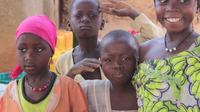Meet Lukman
How an activist ensured that relief money reached a troubled communityTHE APP THAT SAVED 1,000 CHILDREN
INTRODUCTION.
In 2010, health workers discovered an outbreak of lead in northern Nigeria, induced by improper gold mining. Thousands of people were exposed to the life threatening toxin. The government failed to release funds allocated to clean up Bagega, the largest and most contaminated community.
More than 400 children died.
In Nigeria's capital of Abuja, a young activist created a web-based app. The app became a watchdog to make sure that government money would be used to help Bagega and not to go into politicians' pockets. This is the story of how that campaign helped save a blind boy named Lukman and more than 1,000 children from death.
Chapter 1: Lukman
Lukman is 5 years old. He lives in Bagega. The sun drenches the village in heat. In the family compound, he plays with his 9 siblings, tugging at their clothes, tussling in the dirt. He grabs their arms to guide his footsteps. Lukman cannot see his brothers and sisters. He became blind when he was a 1 year old boy.
Largest lead outbreak in modern history
"There, people were exposed to mind-boggling rates of lead contamination. Some residential soil with up to 35,000 parts per million of lead... The United States considers 400 parts per million safe for residential soil." The Associated Press
Some children had up to 700 micrograms per deciliter of lead in their blood (μg/dL). The international standard maximum is 10 (μg/dL).
How did the children get poisoned?A deadly hunt for gold
Like thousands of men in northern Nigeria, Lukman's father toiled in the mines. The price of gold had increased during the 2008 global recession and miners in Nigeria were making more money than they ever had before.
When the father came home from a hard day's work at the mines, his clothes were stained with dust full of lead. And he brought the ores home to process, washing them in mercury. Lukman played with the ores that his father brought home from the mines. That's how he came into direct contact with the lead. The lead damaged Lukman's nervous system, affecting his eyes.
Lukman's father died in a motorbike accident in 2013.
Bagega's children"OUR CHILDREN ARE CONVULSING"
Karima is 3 years old. The lead crept into her blood. She experiences severe convulsions. Her mother said her seizures can last up to one hour.
Meet Hamzat
Chapter 2: Hamzat Follows The Money
300 miles away from the crisis in Bagega is a tech-savvy 24-year-old named Hamzat in the capital city of Abuja.
He left a lucrative job at an influential non-governmental organization to become a full-time activist.
Browsing through local newspapers, he learned about the lead poisoning crisis and the government funds that were being held up.
That's when he decided to start a social media campaign with his friends, called #SaveBagega And he launched the web-based app: "Follow The Money"
SAVING 1,000 CHILDREN
CHAPTER 3: Saving 1,000 Children
After mounting media scrutiny coupled with Follow The Money's popular #SaveBagega campaign, the federal government of Nigeria finally disburses the money, 8 months after its initial promise. $5.2 million USD is distributed to 3 ministries to address specific needs:
* The Ministry of Environment to clean up the lead
* The Ministry of Mines and Steel Development to introduce safer practices to miners
* The Ministry of Health to treat people suffering from high levels of lead
Photo: environmental workers prepare to remove the lead contamination in Bagega
Timeline
August 2010 - A team of health and environmental experts, representing various Nigerian government agencies, conduct a house-to-house survey in Bagega to investigate the lead outbreak
February 2012 - Human Rights Watch releases a report called “Nigeria: Child Lead Poisoning Crisis
May 2012 - President promises N850 million ($5.4 million USD) to help the village of Bagega respond to the lead poisoning crisis
U.S.-based environmental engineering firm TerraGraphics International Foundation in conjuction with state officials submit a proposed budget of about $2.7 million USD to the Federal Ministry of Environment in Nigeria to remediate Bagega













































 THE APP THAT SAVED 1,000 CHILDREN
THE APP THAT SAVED 1,000 CHILDREN
 Chapter 1: Lukman
Chapter 1: Lukman
 Lukman's sister
Lukman's sister
 Love Is blind
Love Is blind
 Largest lead outbreak in modern history
Largest lead outbreak in modern history
 A deadly hunt for gold
A deadly hunt for gold
 "OUR CHILDREN ARE CONVULSING"
"OUR CHILDREN ARE CONVULSING"
 Siama
Siama
 Sanu
Sanu
 Doctors Without Borders
Doctors Without Borders
 A Community In Crisis
A Community In Crisis
 What next?
What next?
 Chapter 2: Hamzat Follows The Money
Chapter 2: Hamzat Follows The Money
 Hamzat on Bagega
Hamzat on Bagega
 A social campaign
A social campaign
 SaveBagega
SaveBagega
 CHAPTER 3: Saving 1,000 Children
CHAPTER 3: Saving 1,000 Children
 Remediation
Remediation
 Timeline
Timeline
 Timeline continued
Timeline continued
 Timeline 3
Timeline 3
 Mother's Love
Mother's Love